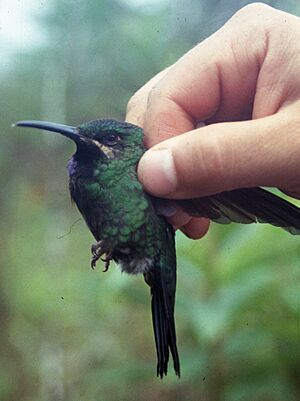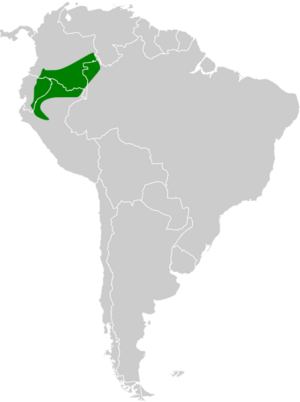Black-throated brilliant facts for kids
Quick facts for kids Black-throated brilliant |
|
|---|---|
 |
|
| Female from Cordillera del Cóndor, Ecuador | |
| Conservation status | |
| Scientific classification | |
| Genus: |
Heliodoxa
|
| Species: |
schreibersii
|
 |
|
The black-throated brilliant (Heliodoxa schreibersii) is a type of hummingbird known for its bright colors. These tiny, fast-flying birds live in parts of South America, including Brazil, Colombia, Ecuador, and Peru. They are called "brilliants" because of their shiny, colorful feathers.
About the Black-throated Brilliant
Scientists sometimes group animals into different categories. For the black-throated brilliant, there are two main types, called subspecies. These are like slightly different versions of the same bird.
- H. s. schreibersii (the "nominate" subspecies)
- H. s. whitelyana
Some scientists think these two types are just subspecies. Others believe they are different enough to be considered completely separate species. This is why you might hear about the "black-throated brilliant" and the "black-breasted brilliant" as distinct birds.
What Does This Hummingbird Look Like?
The black-throated brilliant is a medium-sized hummingbird. It measures about 11.5 to 14 centimeters (4.5 to 5.5 inches) long. Both males and females have a dark, almost straight bill that is about 2.8 centimeters (1.1 inches) long. They also have a small white spot right behind their eye.
Male Black-throated Brilliants
Male birds are usually very colorful.
- Their upper parts are a shining green, with a glittering green forehead.
- Their underparts are black.
- They have a small, glittering purple patch on their lower throat.
- A narrow, glittering green band is also on their lower throat.
- Their tail is a long, steel blue color and is deeply forked, like a "V" shape.
Female Black-throated Brilliants
Female birds look a bit different from the males.
- Their upper parts are similar to the males'.
- They have a whitish or reddish stripe on their cheek.
- Their underparts are gray with bronzy green spots.
- Their central tail feathers are green.
- Their tail is less deeply forked than the male's.
Young Black-throated Brilliants
Young birds, called juveniles, look a lot like the adult females. Their cheek stripe is often more brightly colored.
Where Do Black-throated Brilliants Live?
The black-throated brilliant lives in humid forests and scrublands. They prefer the inside of mature forests.
H. s. schreibersii Habitat
This subspecies is found in:
- Southeastern Colombia
- Eastern Ecuador
- Northeastern Peru (as far as the San Martín area)
- Extreme northwestern Brazil (near the Rio Negro river)
They usually live at elevations between 400 and 1000 meters (1,300 to 3,300 feet) above sea level. Sometimes, in eastern Ecuador, they can be found higher, up to 1,900 meters (6,200 feet).
H. s. whitelyana Habitat
This subspecies lives in central and southeastern Peru. They prefer humid mountain forests. You can find them at elevations between 600 and 1250 meters (2,000 to 4,100 feet).
Black-throated Brilliant Behavior
Hummingbirds are known for their unique behaviors.
Movement and Travel
The black-throated brilliant is known to be sedentary. This means they tend to stay in one place and do not travel long distances.
What Do They Eat?
These hummingbirds mainly eat nectar from flowers. They usually look for nectar in the lower parts of the forest, about 2 to 4 meters (7 to 13 feet) off the ground. They especially like flowers from the Ericaceae and Malvaceae plant families.
Besides nectar, they also catch small insects. They do this by "hawking," which means they fly out from a perch to snatch insects in the air.
Breeding and Nests
The breeding season for the H. s. schreibersii subspecies lasts from at least February to May. It might even go as late as October. The female bird lays two eggs and then sits on them to keep them warm until they hatch. Not much else is known about how these amazing birds raise their young.
Sounds and Calls
The song of the black-throated brilliant is a repeated, drawn-out, descending trill. It sounds like a reeling sound that lasts about 4 to 5 seconds. They also make single "chup" notes. The song of the H. s. whitelyana subspecies is similar, but it lasts about 3 seconds. Scientists are still studying if their songs are truly different.
Conservation Status
The black-throated brilliant is currently listed as a species of "Least Concern" by the IUCN (International Union for Conservation of Nature). This means that, for now, they are not considered to be in immediate danger of extinction.
However, the exact number of these birds is not known. Scientists believe their population might be decreasing. They are not very common and are found in scattered areas. More research is needed to fully understand their situation and ensure they stay safe in the future.


